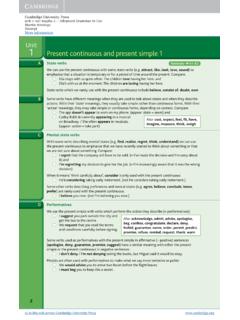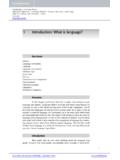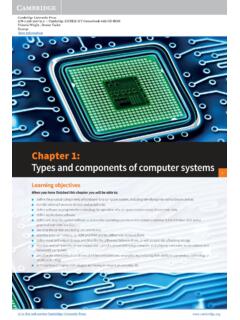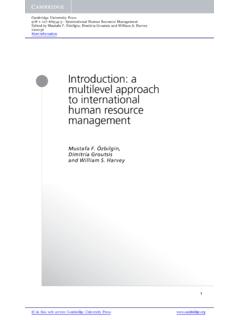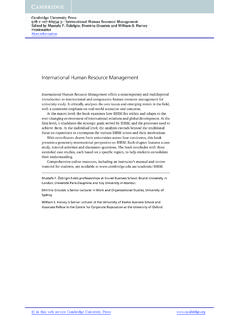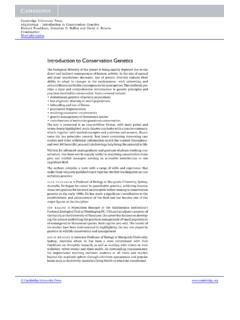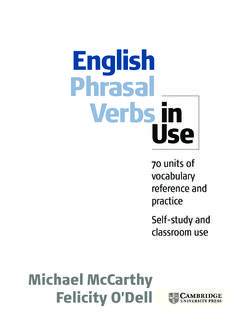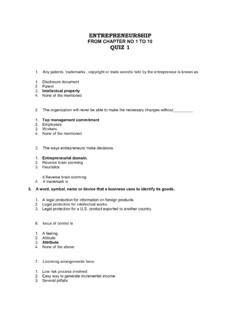Transcription of Business Vocabulary in Use
1 BusinessVocabularyin UseBill MascullPUBLISHED BY THE PRESS SYNDICATE OF THE UNIVERSITY OF CAMBRIDGEThe Pitt Building, Trumpington Street, Cambridge, United KingdomCAMBRIDGE UNIVERSITY PRESSThe Edinburgh Building, Cambridge CB2 2RU, UK40 West 20th Street, New York, NY 10011 4211, USA477 Williamstown Road, Port Melbourne, VIC 3207, AustraliaRuiz de Alarc n 13, 28014 Madrid, SpainDock House, The Waterfront, Cape Town 8001, South Cambridge University Press 2002 This book is in copyright. Subject to statutory exception and to the provisions of relevant collective licensing agreements, no reproduction of any part may take place without the written permission of Cambridge University published 2002 Printed in the United Kingdom at the University Press, CambridgeTypefaceSabon 10 [GECKO LTD]A catalogue record for this book is available from the British LibraryISBN 0 521 77529 93 Business Vocabulary in UseINTRODUCTION8 JOBS, PEOPLE ANDORGANIZATIONSWork and jobs10 AWhat do you do?
2 BWord combinations with work CTypes of job and types of workWays of working12 AOld and new waysBNice work if you can get itCNature of workRecruitment and selection14 ARecruitmentBApplying for a jobCSelection proceduresSkills and qualifications16 AEducation and trainingBSkilled and unskilledCThe right personPay and benefits18 AWages, salary and benefitsBCompensation 1 CCompensation 2 People and workplaces20 AEmployees and managementBManagement and administrationCLabour DPersonnel and human resourcesThe career ladder22AA job for lifeBA job for nowCIn-house staff or freelancers?DLosing your job7654321 Contents1 Problems at work24 AHealth and safetyBBullying and harassmentCDiscriminationManagers, executives and directors26 AManagers and executives: UKBM anagers and executives: USBusinesspeople and Business leaders28 ABusinesspeople and entrepreneursBLeaders and leadershipCMagnates.
3 Moguls and tycoonsOrganizations 130 ABusiness and businessesBCommerceCEnterpriseDWord combinations with enterprise Organizations 232 ASelf-employed people and partnershipsBLimited liabilityCMutualsDNon-profit organizationsPRODUCTIONM anufacturing and services34 AIndustry BManufacturing and servicesCCountries and their industriesThe development process36 AMarket researchBDevelopment and launch1413121110984 Business Vocabulary in UseInnovation and invention38 AInnovation and inventionBResearch and technologyCPatents and intellectual propertyMaking things40 AProductsBMass productionCCapacity and outputMaterials and suppliers42 AInputsBSuppliers and outsourcingCJust-in-timeBusiness philosophies44 ATotal quality managementBContinuous improvementCBenchmarkingDBusiness process re-engineeringMARKETINGB uyers, sellers and the market46 ACustomers and clientsBBuyers and sellersCThe marketDWord combinations with market Markets and competitors48 ACompanies and marketsBMore word combinations with market CCompetitors and competitionMarketing and marketorientation 50 AMarketingBThe four PsCMarket orientation21201918171615 Products and brands52 AWord combinations with product BGoods CBrands and brandingPrice54 APricingBWord combinations with price CUpmarket and downmarketDMass markets and nichesPlace56 ADistribution.
4 Wholesalers, retailers and customersBShopsCDirect marketingPromotion58 AAdvertising BThe sales forceCPromotional activitiesThe Internet and e-commerce60 AThe InternetBClicks-and-mortarCB2B, B2C and B2 GMONEYS ales and costs62 ASales 1 BSales 2 CCostsDMargins and mark-upsProfitability and unprofitability64 AProfitable and unprofitable productsBBudgets and expenditureCEconomies of scale and the learning curve282726252423225 Business Vocabulary in UseGetting paid66 AShipping and billingBTrade creditCAccountsAssets, liabilities and the balance sheet 68 AAssetsBDepreciationCLiabilitiesDBalance sheetThe bottom line 70 AAccountsBResultsShare capital and debt72 ACapitalBShare capitalCLoan capitalDSecurityELeverageSuccess and failure74 ACash mountains and surplusesBDebt and debt problemsCTurnarounds and bailoutsDBankruptcyMergers, takeovers and sell-offs76 AStakes and joint venturesBMergers and takeoversCConglomeratesFINANCE AND THE ECONOMYP ersonal finance78 ATraditional bankingBNew ways of bankingCPersonal investing35343332313029 Financial centres 80 AFinancial centresBStock marketsCOther financial marketsDDerivativesTrading82 AMarket indexesBMarket activity: good times.
5 And bad timesIndicators 184 AFinance and economicsBInflation and unemploymentCTradeDGrowth and GDPI ndicators 286 AGoing upBGoing downCPeaks and troughsDBoom and bustDOING THE RIGHT THINGW rongdoing and corruption88 AWrongdoingBBribery and corruptionCFraud and embezzlementEthics90 ACode of ethicsBEthical standardsCEthical investmentPERSONAL SKILLSTime and time management92 ATimeframes and schedules BProjects and project managementCTime tips424140393837366 Business Vocabulary in UseStress and stress management 94 AWhen work is stimulatingBWhen stimulation turns to stressCDownshiftingLeadership and management styles 96 ALeadershipBModern management stylesCEmpowermentCULTUREB usiness across cultures 198 ACultures and cultureBDistance and familiarityBusiness across cultures 2100 ANamesBBusiness cardsCDressBusiness across cultures 3102 AEntertainment and hospitalityBTimeCCross-cultural communicationTELEPHONE, FAX AND EMAILT elephoning 1: phones and numbers 104 ATelephones and beyondBPhone, call and ringCNumbersDDoing things over the phoneTelephoning 2: getting through 106 APhoning scenarioBAsking to speak to someone 1 CVoicemail49484746454443 Telephoning 3: messages 108 AAsking to speak to someone 2 BGiving and taking messagesCSpelling namesDTaking messages: checking informationTelephoning 4: arrangements 110 AMaking arrangementsBClosing the conversationCChanging arrangementsFaxes 112 ASending faxesBFax layoutCReceiving faxesEmails 114 AEmailBEmail expressionsCEmail abbreviationsBUSINESS SKILLSM eetings 1.
6 Types of meeting 116 AWord combinations with meeting BTypes of meetingCHow was the meeting?Meetings 2: the role of the chairperson118 ABefore the meetingBDuring the meetingCFollow-upMeetings 3: points of view120 AOpening the meetingBInviting people to speakCMaking your point565554535251507 Business Vocabulary in UseNegotiations 3: furtheringnegotiations 136 AWin winBProbingCProposal and counter-proposalDTrade-offsNegotiations 4: difficulties138 AConfrontationBConfrontational negotiating tacticsCDealing with problemsNegotiations 5: reachingagreement 140 ADeadlock and mediatorsBAgreements and contractsCChecking the dealAnswer key142 Index160666564 Meetings 4: agreement and disagreement122 ADiscussion without argument?BAgreeingCDisagreeingMeetings 5: discussiontechniques124 AHedgingBChecking understanding, interrupting,referring backCAgreement, consensus or compromise?
7 DConcludingPresentations 1: preparation and introduction126 ATypes of presentationBDos and don ts: preparationCKey phrases: introductionPresentations 2: main part128 ADos and don ts: timingBDos and don ts: voiceCRapport with the audienceDKey phrases: main partPresentations 3: closing and questions 130 ADos and don ts: body languageBVisual aidsCKey phrases: closing and dealing withquestionsNegotiations 1: situations and negotiators132 ATypes of negotiationBWord combinations with negotiations CBargaining Negotiations 2: preparing134 APreparing to negotiateBNegotiating scenarioCNegotiating styles636261605958578 Business Vocabulary in UseIntroductionWho is this book for? Business Vocabulary in Useis designed to help intermediate and upper-intermediatelearners of Business English improve their Business Vocabulary . It is for peoplestudying English before they start work and for those already working who needEnglish in their from improving your Business Vocabulary , the book also helps you to developthe language needed for important Business communication can use the book on your own for self-study, or with a teacher in the classroom,one-to-one or in is the book organised?
8 The book has 66 two-page units. The first 46 of these units are thematicand look at the Vocabulary of Business areas suchas people, organisations, production, marketing, finance and Business -related economics. The other 20 units focus on the language of skillsyou need in Business , such as thosefor presentations, meetings, telephoning and left-hand page of each unit explains new words and expressions, and the right-hand page allows you to check and develop your understanding of them and howthey are used through a series of is cross-referencingbetween units to show connections between the same wordor similar words used in different is an answer keyat the back of the book. Most of the exercises have questionswith only one correct answer. But some of the exercises, including the Over to youactivities at the end of each section (see below), are designed for writing and/ordiscussion about yourself and your own is also an index.
9 This lists all the new words and phrases introduced in thebook and gives the unit numbers where they appear. The index also tells you how thewords and expressions are left-hand pageThis page introduces new Vocabulary and expressions for each thematic or skills presentation is divided into a number of sections indicated by letters: A, B, C,etc, with simple, clear well as explanations of Vocabulary , there is information about typical wordcombinations and the grammar associated with particular Vocabulary , for examplethe verbs that are typically used with particular are notes on mistakes to avoid, for example:You can t say that someone is 'a responsible'.There are also notes about differences between British and American : CV; AmE: r sum or resume9 Business Vocabulary in UseThe right-hand pageThe exercises on the right-hand page give practice in using the new Vocabulary andexpressions presented on the left-hand page.
10 Sometimes the exercises concentrate onusing the words or expressions presented on the left-hand page in context. Otherexercises practise the grammatical forms of items from the left-hand page. Some unitscontain diagrams to complete, or crosswords. Over to you sectionsAn important feature of Business Vocabulary in Useis the Over to yousection at theend of each unit. There are sometimes alternative Over to yousections, for learnerswho are in work and those who are not. The Over to yousections give you thechance to put into practice the words and expressions in the unit in relation to yourown professional situation, studies or learners can do this section as a written activity. In the classroom, the Over to yousections can be used as the basis for discussionwith the whole class, or in small groups with a spokesperson for each groupsummarising the discussion and its outcome for the class.

